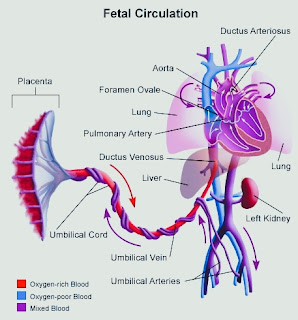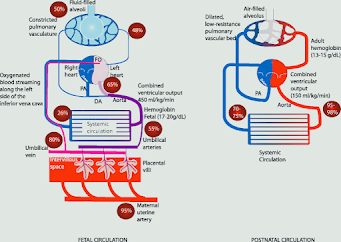Fetal circulation also known as fetoplacental circulation includes the umbilical cord and the blood vessels within the placenta that carry fetal blood.
Fetus is connected to the placenta by the umbilical cord. Fetal circulation differs from postnatal circulation since lungs are not of use. Fetus receives the necessary nutrients and oxygen through the blood vessels in the umbilical cord from the placenta and also serves as the way through which the deoxygenated blood reaches the placenta to get oxygenated and there is exchange of waste produced by the fetus.
Fetal circulation consists of three shunts:
- DUCTUS VENOSUS
- FORAMEN OVALE
- DUCTUS ARTERIOSUS
- Blood enters the right atrium. As the blood enters the right atrium, most of it flows through the foramen ovale into the left atrium.
- Blood then passes into the left ventricle and then into the aorta.
- From the aorta, blood is sent to the heart muscle itself in addition to the brain and upper limbs. The blood returns to the right atrium of the heart through the superior vena cava from brain, heart and the upper limbs. About two thirds of the blood passes through the foramen ovale, while the remaining one third passes into the right ventricle, toward the lungs.
- In the fetus, the placenta does the work of breathing instead of the lungs, thereby only a small amount of the blood continues on to the lungs. Most of this blood is bypassed or shunted away from the lungs through the Ductus arteriosus to the aorta and most of the circulation to the lower body is supplied by blood passing through the ductus arteriosus via the descending aorta which then reaches the lower limbs.
- The blood then enters the umbilical arteries and reaches the placenta. In the placenta, carbon dioxide and waste products are released, and oxygen and nutrients are exchanged and the oxygenated blood thus enters the umbilical vein.
The umbilical cord is clamped at birth and thus, the baby no longer receives oxygen and nutrients from the mother. As the baby starts breathing its first breaths, the lungs begin to expand. As the lungs expand, the fluid in the lungs is cleared. There is also an increase in the baby's blood pressure and a significant reduction in the pulmonary pressure which reduces the need for the ductus arteriosus to shunt blood. These changes lead to the closure of the shunt. These changes also increase the pressure in the left atrium of the heart, and decrease the pressure in the right atrium. The closure of foramen ovale is stimulated by this shift in pressure. The closure of the ductus arteriosus and foramen ovale completes the transition of fetoplacental circulation to newborn circulation.
Thank you for reading and keep supporting us. We will be posting regularly about commonly asked medical queries
Click on the following TOPIC to know more about :
CLAVICLE - LONG BONE OR FLAT BONE


Super work
ReplyDelete